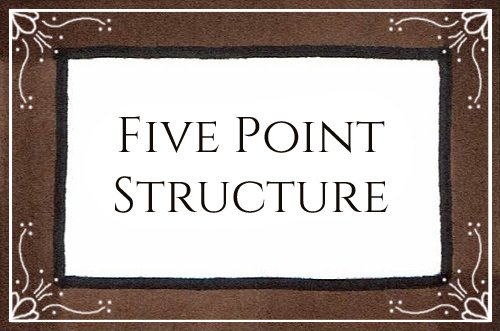Exploring Story Structure
Possibly the biggest learning curve for me in becoming a writer has been story structure. How do I connect the events in my story so that they build on each other and form an elegant, cohesive whole that is a "story" and not a vignette, an essay, or report? Here I share some of what I've learned.
WHY DOES STORY STRUCTURE EVEN MATTER?
The question of whether and how much story structure matters appears to be one that can elicit rather a lot of debate in some quarters. My increasingly strong opinion is that structure matters a great deal for a number of reasons, three of which are audience expectations, professional craftsmanship, and ease of construction.
Apples to Apples: Comparing Story Structures
After studying nine popular models for structuring stories, I found myself noticing that there were certain touch points that occurred in all of the models. They wore different names, and were described a little differently, but they were there. [I have since observed the same touch points in many other story structure models.]
I decided to make myself a chart in which those touch points were visually aligned and see what happened with the rest of the pieces of each structure model. What I discovered was . . .
Three Act Structure
The three act story structure has been described, and analysed, and argued about since Aristotle, who posited that a whole story has a beginning, a middle, and an end. Although this might seem obvious to the point of absurdity, the very longevity of the idea should keep good writers from dismissing it out of hand.
Four Act Structure
The four acts in this structure have acquired various names from different analysts, but in this discussion I'll refer to them as the Set-up, Response, Attack, and Resolution.
This structure is essentially the same as a three act structure in which the second act, which is lengthy and sometimes difficult to handle all in one chunk, has been broken into two more manageable parts. This produces four acts of roughly equal length.
Five Point Structure
The German playwright and novelist Gustav Freytag built stories in five parts.
Essentially, this is the same as the 4-act structure, but with the midpoint climax from the 3-act structure added back in as a distinct portion of the story rather than just existing as the break between acts 2 and 3 as it does in the 4-act structure.
Seven Point Structure
This structure is very similar to the 5-point structure, but with two “pinch points” added to help increase the tension.
Eight Point Structure
The next model I want to look at uses eight points to describe the basic structure of a story. It’s much like the seven-point structure, but with the first plot turn broken into two parts, the “trigger” and the “quest”.
Here's a run-down of the eight points in this model as described in Nigel Watts's book Write a Novel - and Get It Published.
Save the Cat
Another popular model for structuring stories comes from Blake Snyder's popular book on screenwriting, Save the Cat. Of course, Blake Snyder goes into much more detail and has a lot of other good thoughts to share, so if this model appeals to you, definitely read his book.
The Hero’s Journey
The next story model I'd like to briefly discuss is called The Hero's Journey. It's based on the work of scholar Joseph Campbell who, in his book The Hero With A Thousand Faces, examined the mythic stories of the past and identified certain patterns that kept surfacing over and over.
Christopher Vogler translates Campbell's theories into practical application for writers in his book, The Writer's Journey: Mythic Structure for Writers. And, of course, the idea of the Hero’s Journey is so popular that a quick internet search will turn up piles of additional information and discussion on this topic.
The Virgin’s Promise
The Virgin's Promise story structure was introduced by Kim Hudson, and you can read more about it in her book, The Virgin's Promise: Writing Stories of Feminine Creative, Spiritual, and Sexual Awakening.
This story structure was developed somewhat in reaction to the Hero's Journey structure that I described in my previous post, and is presented by Hudson as a "feminine" story structure, though she stresses that the "virgin" in the tale can be either male or female, just as the "hero" in the Hero's Journey can be of either sex.
The beats she identifies are as follows:
Story Trumps Structure
In an examination of story structure, I could hardly leave out Steven James's excellent book, Story Trumps Structure, which I greatly enjoyed and strongly recommend. I will admit, though, that I put off reading it for a while because I thought I ought to gain a solid understanding of what story structure was before I read Mr. James's argument as to why I shouldn't worry about it. If you want to understand a counter argument, it really helps to have a good grasp of the argument.
Story Structure Comparison Chart
Click image to view interactive chart
(Note: This will take you to an external page at Miro.com)












